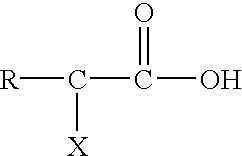Post clean treatment
- Summary
- Abstract
- Description
- Claims
- Application Information
AI Technical Summary
Problems solved by technology
Method used
Image
Examples
example 1
Experiments were done to determine the "buffering capacity" or amine neutralization power of Post Clean Treatment. The chemistry was designed to neutralize amines until the solution reaches pH 7. Once the pH goes above this value (becomes more caustic) the possibility of metal corrosion increases.
The general procedure for the test was to use a 100 gm sample of the Post Clean Treatment solution (89 parts water, 8 parts citric acid and 3 parts 50% hydroxylamine) in a beaker with a magnetic stirring bar. The pH was monitored with a Fisher pH meter that had a two point calibration.
Various amine chemistries were added until a pH of 7 was reached.
Percent in Final Solution=amine quantity / 100 gm Post Clean Treatment+amine. DGA=diglycolamine; HDA.RTM.=hydroxylamine (expressed as percentage of a commercially available 50 wt % aqueous solution); MEA=monoethanolamine; NMP=N-methyl pyrrolidone. HDA.RTM. is a registered trademark of EKC Technology, Inc.
The amine and amine / hydroxylamine chemistrie...
example 2
Patterned wafers were tested with the Post Clean Treatment solution used in Example 1 doped with amine wet chemistries to simulate the effect of hydroxylamine and / or amine wet chemistries dragout. FIG. 5A shows a patterned wafer before processing with any wet chemistry as a control. The patterned wafers were immersed in the doped solutions for 30 minutes before being rinsed with DI water. FIG. 5B shows the results obtained with the Post Clean Treatment solution of Example 1 to which was added 10 weight percent of solution E (Table III). FIG. SC shows the results obtained with the Post Clean Treatment solution of Example 1 to which was added 8 weight percent of solution C (Table III). These SEM photographs further show that there is no attack of the metal structure after passing through the Post Clean Treatment solution "doped" with various hydroxylamine and / or amine chemistries.
Idea 3
Currently tungsten metal CMP planarization chemistries are either hydrogen peroxide or ferric nitrat...
example 3
The following data shows the effect of rinses composed of organic acids and buffered with either hydroxylamine or ammonium hydroxide to a final pH of 4.5.
Titanium coupons (1.33 g) and a Ti wafer with 4000 .ANG. were placed in the solutions or 24 hours at room temperature. The samples were rinsed with IPA and water and dried and then weighed.
The data shows that metal samples processed through hydroxylamine buffered solutions are not etched (loss weight) but have slight weight gain (gain oxide thickness).
Other post treatment solutions were also tested.
Titanium coupons and Ti wafers (4000 .ANG.) were placed in solution C of Example 1 that was heated to 65.degree. C. for 30 minutes. The samples were then transferred to an IPA solution or to the treatment solutions.
The data shows that though there is solution C chemistry being carried into the IPA or treatment solutions there was no adverse effects (weight loss). One practiced in the art would expect no effect from the IPA rinse, because...
PUM
| Property | Measurement | Unit |
|---|---|---|
| Fraction | aaaaa | aaaaa |
| Fraction | aaaaa | aaaaa |
| Fraction | aaaaa | aaaaa |
Abstract
Description
Claims
Application Information
 Login to View More
Login to View More - R&D
- Intellectual Property
- Life Sciences
- Materials
- Tech Scout
- Unparalleled Data Quality
- Higher Quality Content
- 60% Fewer Hallucinations
Browse by: Latest US Patents, China's latest patents, Technical Efficacy Thesaurus, Application Domain, Technology Topic, Popular Technical Reports.
© 2025 PatSnap. All rights reserved.Legal|Privacy policy|Modern Slavery Act Transparency Statement|Sitemap|About US| Contact US: help@patsnap.com



